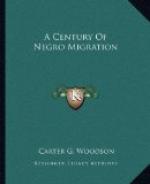Negroes migrated to the West Indies in spite of this warning and protest. Hayti, at first looked upon with fear of having a free Negro government near slaveholding States, became fixed in the minds of some as a desirable place for the colonization of free persons of color.[20] This was due to the apparent natural advantages in soil, climate and the situation of the country over other places in consideration. It was thought that the island would support fourteen millions of people and that, once opened to immigration from the United States, it would in a few years fill up by natural increase. It was remembered that it was formerly the emporium of the Western World and that it supplied both hemispheres with sugar and coffee. It had rapidly recovered from the disaster of the French Revolution and lacked only capital and education which the United States under these circumstances could furnish. Furthermore, it was argued that something in this direction should be immediately done, as European nations then seeking to establish friendly relations with the islands, would secure there commercial advantages which the United States should have and could establish by sending to that island free Negroes especially devoted to agriculture.
In 1836, Z. Kingsley, a Florida planter,[2l] actually undertook to carry out such a plan on a small scale. He established on the northeast side of Hayti, near Port Plate, his son, George Kingsley, a well-educated colored man of industrious habits and uncorrupted morals, together with six “prime African men,” slaves liberated for that express purpose. There he purchased for them 35,000 acres of land upon which they engaged in the production of crops indigenous to that soil.
Hayti, however, was not to be the only island to get consideration. In 1834 two hundred colored emigrants went from New York alone to Trinidad, under the superintendence and at the expense of planters of that island. It was later reported that every one of them found employment on the day of arrival and in one or two instances the most intelligent were placed as overseers at the salary of $500 per annum. No one received less than $1.00 a day and most of them earned $1.50. The Trinidad press welcomed these immigrants and spoke in the highest terms of the valuable services they rendered the country.[22] Others followed from year to year. One of these Negroes appreciated so much this new field of opportunity that he returned and induced twenty intelligent free persons of color living in Annapolis, Maryland, also to emigrate to Trinidad.[23]
The New York Sun reported in 1840 that 160 colored persons left Philadelphia for Trinidad. They had been hired by an eminent planter to labor on that island and they were encouraged to expect that they should have privileges which would make their residence desirable. The editor wished a few dozen Trinidad planters would come to that city on the same business and on a much larger scale.[24]




